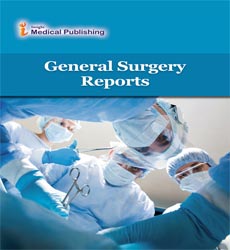Laparoscopic vs. Open Surgery: Comparative Outcomes in Abdominal Procedures
*Corresponding author:
Elang Dharma,
Department of Orthopaedics and Trauma Surgery, University Hospital Bonn, 53127 Bonn, Germany,
E-mail: dharma.elang@ukbonn.de
Received date: February 03, 2025, Manuscript No. ipgsr-25-20672; Editor assigned date: February 05, 2025, PreQC No. ipgsr-25-20672 (PQ); Reviewed date: February 10, 2025, QC No. ipgsr-25-20672; Revised date: February 17, 2025, Manuscript No. ipgsr-25-20672 (R); Published date: February 24, 2025
Citation: Dharma E (2025) Laparoscopic vs Open Surgery: Comparative Outcomes in Abdominal Procedures. Gen Surg Rep Vol. 09 No.1:171.
Introduction
Surgical intervention remains a cornerstone in the management of a wide range of abdominal conditions, including appendicitis, cholelithiasis, colorectal malignancies and hernias. Traditionally, open surgery has been the standard approach, involving larger incisions and direct visualization of abdominal structures. Over the past few decades, laparoscopic surgery has emerged as a minimally invasive alternative, utilizing small incisions, specialized instruments and a camera to perform complex procedures. The adoption of laparoscopic techniques has revolutionized abdominal surgery, promising reduced postoperative pain, shorter hospital stays, faster recovery and improved cosmetic outcomes. Despite its widespread use, there is ongoing debate regarding the comparative outcomes of laparoscopic versus open surgery in terms of operative time, intraoperative complications, postoperative recovery, long-term morbidity and overall patient satisfaction. While laparoscopic surgery offers the advantages of reduced tissue trauma and enhanced visualization in confined spaces, it may be technically demanding, requiring advanced training and specialized equipment. Conversely, open surgery provides direct tactile feedback, easier access to complex anatomical regions and may be preferable in cases of severe adhesions, large tumors, or emergency scenarios. Evaluating the comparative outcomes of these approaches is essential for guiding clinical decision-making, optimizing patient-centered care and allocating healthcare resources effectively. This article reviews the current evidence on laparoscopic and open abdominal surgery, highlighting operative, postoperative and long-term outcomes to inform surgical practice [1].
Description
The primary distinction between laparoscopic and open surgery lies in the surgical access and the degree of invasiveness. Laparoscopic procedures involve multiple small incisions, typically ranging from 0.5 to 1.5 centimeters, through which a camera and specialized instruments are introduced. The operative field is visualized on a monitor, allowing the surgeon to manipulate tissues with high precision. Open surgery, by contrast, requires a larger incision to provide direct access and visualization of abdominal organs, facilitating tactile assessment and manual dissection. These fundamental differences influence several key outcome parameters, including operative time, intraoperative complications, postoperative recovery, pain levels and long-term morbidity [2]. Operative time is a frequently cited metric in comparing laparoscopic and open approaches. Early reports indicated longer operative times for laparoscopic procedures due to the learning curve associated with instrument handling and intracorporeal suturing.
However, with increased surgeon experience and technological advancements, operative durations for laparoscopic surgeries have become comparable to, or in some cases shorter than, open procedures, particularly for routine operations such as laparoscopic cholecystectomy or appendectomy. Complex procedures, including laparoscopic colorectal resections, may still require longer operating times due to meticulous dissection and intracorporeal anastomosis. Nevertheless, the benefits of minimally invasive techniques in terms of postoperative recovery often outweigh the slightly increased operative time in appropriately selected patients [1].
Intraoperative complications represent another important consideration. Laparoscopic surgery carries a unique risk profile, including trocar injuries, bowel perforation and vascular injuries associated with limited tactile feedback and reduced depth perception. Conversely, open surgery allows direct visualization and palpation, potentially reducing certain technical complications. However, open surgery is associated with increased blood loss, higher rates of wound infection and greater tissue trauma, which can lead to longer recovery times and delayed return to normal activities. Systematic reviews and meta-analyses generally indicate that, in elective procedures, laparoscopic surgery is associated with lower intraoperative blood loss, fewer postoperative infections and reduced incidence of surgical site complications [2].
Conclusion
The comparative evaluation of laparoscopic versus open abdominal surgery demonstrates clear advantages of minimally invasive techniques in terms of postoperative recovery, pain control, hospital stay, cosmesis and patient satisfaction. Laparoscopic surgery offers reduced tissue trauma, lower complication rates and favorable long-term functional outcomes while maintaining comparable efficacy to open surgery in both benign and malignant conditions. Open surgery, however, remains indispensable for complex, emergent, or anatomically challenging cases where direct visualization and tactile feedback are critical. Optimal outcomes depend on careful patient selection, individualized treatment planning, surgeon expertise and adherence to evidence-based protocols. Technological advancements, including high-definition imaging, advanced energy devices and robotic-assisted platforms, continue to enhance the precision and safety of laparoscopic procedures, expanding their applicability to increasingly complex abdominal surgeries. While initial equipment costs may be higher, reduced postoperative morbidity, faster recovery and improved patient satisfaction support the cost-effectiveness of minimally invasive approaches.
Ultimately, the decision between laparoscopic and open surgery should be guided by clinical indications, patient-specific factors, institutional resources and surgeon proficiency. Both approaches remain valid and effective, with laparoscopic surgery offering distinct advantages in appropriately selected cases. Integrating current evidence, technological innovations and patient-centered care principles ensures that abdominal surgical interventions achieve optimal clinical outcomes, minimize complications and enhance overall quality of life for patients undergoing these procedures.
Acknowledgement
None.
Conflict of Interest
None.
Reference
- Sayed AI (2022) Case report: Spontaneous coronary artery rupture presenting with acute coronary syndrome: A rare diagnosis of common disease. Front Cardiovasc Med 9: 922180.
Google Scholar Cross Ref Indexedat
- Cheng ST, Liu CJ, Huang HL, Ko YL (2021) Rescue coilization for spontaneous coronary artery JACC Cardiovasc Interv 14: e149-e150.
Open Access Journals
- Aquaculture & Veterinary Science
- Chemistry & Chemical Sciences
- Clinical Sciences
- Engineering
- General Science
- Genetics & Molecular Biology
- Health Care & Nursing
- Immunology & Microbiology
- Materials Science
- Mathematics & Physics
- Medical Sciences
- Neurology & Psychiatry
- Oncology & Cancer Science
- Pharmaceutical Sciences
